Nec VERSA 4200 user Manual
PROPRIETARY NOTICE AND LIABILITY DISCLAIMER
The information disclosed in this document, including all designs and related materials, is the valuable property of NEC Corporation (NEC) and/or its licensors. NEC and/or its licensors, as appropriate, reserve all patent, copyright and other proprietary rights to this document, including all design, manufacturing, reproduction, use, and sales rights thereto, except to the extent said rights are expressly granted to others.
The NEC product(s) discussed in this document are warranted in accordance with the terms of the Warranty Statement accompanying each product. However, actual performance of each such product is dependent upon factors such as system configuration, customer data, and operator control. Since implementation by customers of each product may vary, the suitability of specific product configurations and applications must be determined by the customer and is not warranted by NEC.
To allow for design and specification improvements, the information in this document is subject to change at any time, without notice. Reproduction of this document or portions thereof without prior written approval of NEC is prohibited.
Versa is a U.S. registered trademark of NEC Technologies, Inc.
All other product, brand, or trade names used in this publication are the trademarks or registered trademarks of their respective trademark owners.
First Printing — June 1996
Copyright 1996 |
Copyright 1996 |
NEC Technologies, Inc. |
NEC Corporation |
1414 Massachusetts Avenue |
7-1 Shiba 5-Chome, Minato-Ku |
Boxborough, MA 01719 |
Tokyo 108-01, Japan |
All Rights Reserved |
All Rights Reserved |

Using this Guide
The NEC Versa® 4200 Series User’s Guide gives you the information you need to maximize the use of your Versa 4200 notebook computer. Read this guide to familiarize yourself with the Versa 4200 and its features. For specific information see:
TChapter 1, “Getting Started,” to acquaint yourself with system hardware.
TChapter 2, “Introducing the Software,” for a concise summary of the applications pre-installed on your system. We included software to let you experience the full spectrum of the system, from using the speakers to creating vivid presentations.
TChapter 3, “Using Setup,” to customize your notebook’s parameter and power management settings.
TChapter 4, “Using the Hardware,” for an understanding of NEC Versa 4200 features and functionality. You’ll also master procedures for connecting external options like headphones, microphones, or speakers.
TChapter 5, “Using Multimedia,” for steps on integrating video and sound clips into impressive presentations.
TChapter 6, “Traveling with Your Versa 4200,” lists valuable tips for getting the most out of your system while on the road.
TChapter 7, “Solving Problems,” provides simple solutions to common problems that may arise while operating your notebook.
TAppendix A, “Setting Up a Healthy Work Environment,” provides guidelines to help promote a healthy work setting.
Using this Guide ix
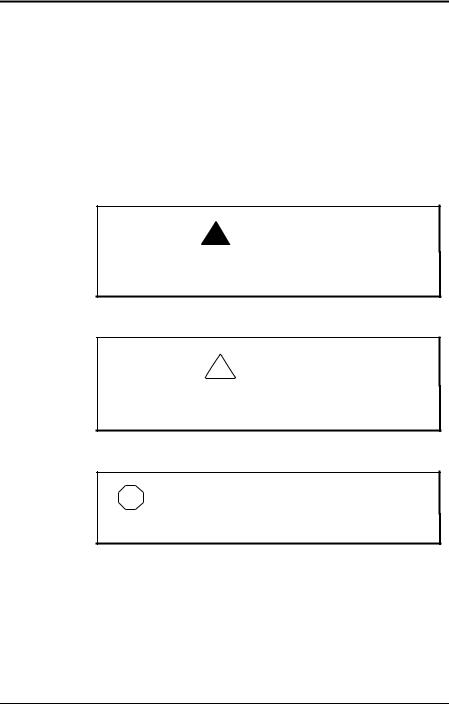
TAppendix B, “Specifications and Environment,” reviews the NEC Versa 4200 system specifications.
TEXT SETUP
To make this guide as easy to use as possible, text is set up in the following ways:
TWarnings, cautions, and notes have the following format.
! WARNING
Warnings alert you to situations that could result in serious personal injury or loss of life.
! CAUTION
Cautions indicate situations that can damage the system hardware or software.
NOTE
Notes give particularly important information about whatever is being described.
TNames of keys are printed as they appear on the keyboard, for example, Ctrl, Alt, or Enter.
TText that you must type or keys that you must press are presented in bold type. For example, type dir and press
Enter.
xUsing this Guide

RELATED DOCUMENTS
See the following documents for information related to the NEC Versa 4200 system operation:
TYour NEC Versa 4200 Quick Setup Sheet.
TYour NEC Versa 4200 Quick Reference Card.
TThe Microsoft® Windows for Workgroups, Windows 95, and MS-DOS operating system online documentation that comes with your NEC Versa 4200 computer.
Using this Guide xi

(For United States Use Only)
FEDERAL COMMUNICATIONS COMMISSION RADIO FREQUENCY INTERFERENCE STATEMENT
WARNING: Changes or modifications to this unit not expressly approved by the party responsible for compliance could void the user’s authority to operate the equipment.
NOTE: This equipment has been tested and found to comply with the limits for a Class B digital device, pursuant to Part 15 of the FCC Rules. These limits are designed to provide reasonable protection against harmful interference in a residential installation. This equipment generates, uses and can radiate radio frequency energy and, if not installed and used in accordance with the instructions, may cause harmful interference to radio communications.
However, there is no guarantee that interference will not occur in a particular installation. If this equipment does cause harmful interference to radio or television reception, which can be determined by turning the equipment off and on, the user is encouraged to try to correct the interference by one or more of the following measures.
TReorient or relocate the receiving antenna.
TIncrease the separation between the equipment and receiver.
TConnect the equipment to an outlet on a circuit different from the one to which the receiver is connected.
Use a shielded and properly grounded I/O cable to ensure compliance of this unit to the specified limits of the rules.
(For Canadian Use Only)
This equipment is a Class B digital apparatus which complies with the Radio Interference Regulations, C.R.C., c.1374.
Cet appareil numérique de la classe B est conforme àu Règlement sur le brouillage radioélectrique, C.R.C., ch.1374.

Contents
Using this Guide |
|
Text Setup.......................................................................................... |
x |
Related Documents ............................................................................. |
xi |
1 Getting Started |
|
Getting To Know Your NEC Versa 4200 ............................................ |
1-2 |
Around the System – Front ............................................................ |
1-3 |
LCD......................................................................................... |
1-3 |
Controls and Microphone.......................................................... |
1-4 |
Status Icons .............................................................................. |
1-5 |
Keyboard.................................................................................. |
1-7 |
Infrared (IR) Port...................................................................... |
1-7 |
NEC VersaGlide....................................................................... |
1-7 |
Diskette Drive, CD-ROM Reader, and the NEC VersaBay II™. 1-8 |
|
Around the System — Back ................................................................ |
1-9 |
Around the System — Left Side .......................................................... |
1-10 |
Around the System — Right Side ........................................................ |
1-11 |
Around the System — Bottom ............................................................. |
1-12 |
Power Sources For Your NEC Versa .................................................. |
1-13 |
Using the AC Adapter.................................................................... |
1-13 |
Powering on.............................................................................. |
1-15 |
Using the Main Battery Pack.......................................................... |
1-15 |
Replacing the Battery Pack ....................................................... |
1-17 |
Extended Battery Life .................................................................... |
1-20 |
Using the NEC Versa 4000 DC Car Adapter.................................. |
1-20 |
Internal Li-Ion Batteries ................................................................. |
1-21 |
CMOS Battery ......................................................................... |
1-21 |
Bridge Battery .......................................................................... |
1-21 |
System Care ....................................................................................... |
1-21 |
Precautions.................................................................................... |
1-21 |
NEC Versa 4200 and AC Adapter............................................. |
1-21 |
Lithium-Ion Battery .................................................................. |
1-22 |
Storage Requirements .................................................................... |
1-24 |
Routine Cleaning ........................................................................... |
1-24 |
Contents iii

2 Introducing the Software |
|
Windows Introduction......................................................................... |
2-2 |
Windows 95 .................................................................................. |
2-2 |
Windows for Workgroups .............................................................. |
2-3 |
DOS Introduction ............................................................................... |
2-4 |
Guide to On-Line Help........................................................................ |
2-4 |
NEC Versa 4200 InfoCenter .......................................................... |
2-4 |
Additional On-line Topics .............................................................. |
2-6 |
Guide To NEC Utilities....................................................................... |
2-6 |
NEC Diskette Creator .................................................................... |
2-6 |
NEC Battery Gauge....................................................................... |
2-7 |
PowerPanel.................................................................................... |
2-7 |
PHDisk.......................................................................................... |
2-7 |
CardWizard ................................................................................... |
2-8 |
Other Software ................................................................................... |
2-8 |
Official Airline Guide (OAG)......................................................... |
2-8 |
LapLink ........................................................................................ |
2-9 |
When to Use LapLink ............................................................... |
2-9 |
How to Use LapLink................................................................. |
2-10 |
On-line Services............................................................................. |
2-11 |
America Online......................................................................... |
2-13 |
CompuServe ............................................................................. |
2-13 |
Netscape Navigator................................................................... |
2-13 |
McAfee Anti Virus Software.......................................................... |
2-14 |
XingMPEG Player™ and Presentation Software ............................ |
2-15 |
ESS Audio/Audio Rack ................................................................. |
2-15 |
NeoMagic Video Configuration Utility – Windows for Workgroups 2-15 |
|
NeoMagic Property Page for Windows 95...................................... |
2-17 |
3 |
Using Setup |
|
|
Setup Utility ....................................................................................... |
3-1 |
|
How to Enter Setup........................................................................ |
3-1 |
|
How to Use Setup .......................................................................... |
3-2 |
|
Looking at Screens.................................................................... |
3-2 |
|
Using Keys ............................................................................... |
3-3 |
|
Checking/Setting System Parameters......................................... |
3-4 |
|
PowerPanel......................................................................................... |
3-9 |
|
Reviewing PowerPanel Default Power Settings............................... |
3-10 |
|
Reviewing PowerPanel Default Command Settings......................... |
3-11 |
|
|
|
iv |
Contents |
|

PowerPanel Menu.......................................................................... |
3-11 |
Preferences ............................................................................... |
3-12 |
Customize................................................................................. |
3-12 |
Profile Manager........................................................................ |
3-12 |
Minimize .................................................................................. |
3-13 |
Help ......................................................................................... |
3-13 |
Setup Utility and PowerPanel......................................................... |
3-13 |
4 Using The Hardware |
|
LCD Panel.......................................................................................... |
4-1 |
Keyboard............................................................................................ |
4-2 |
NEC VersaGlide................................................................................. |
4-4 |
Making VersaGlide Adjustments ............................................... |
4-5 |
Changing the Button Configuration ........................................... |
4-6 |
VersaGlide Ergonomic Tips ...................................................... |
4-6 |
NEC VersaBay II ............................................................................... |
4-7 |
Removing a Device from the VersaBay II....................................... |
4-7 |
Installing a Device in the VersaBay II............................................. |
4-9 |
Customizing Your System with the VersaBay II ............................. |
4-10 |
6x CD-ROM Reader...................................................................... |
4-11 |
CD Loading.............................................................................. |
4-13 |
CD Care ................................................................................... |
4-13 |
PC Card Slots (PCMCIA).............................................................. |
4-14 |
IR Port .......................................................................................... |
4-15 |
Increasing System Storage And Memory ............................................. |
4-16 |
Hard Disk...................................................................................... |
4-16 |
Installing a Memory Card .............................................................. |
4-20 |
Installing Options................................................................................ |
4-22 |
External Monitor ........................................................................... |
4-23 |
Printer ........................................................................................... |
4-24 |
Parallel Devices ........................................................................ |
4-24 |
Serial Devices........................................................................... |
4-26 |
External Keyboard/Mouse.............................................................. |
4-27 |
External Bar Code Scanner ............................................................ |
4-29 |
External Audio Options.................................................................. |
4-29 |
Docking the NEC Versa 4200 ........................................................ |
4-30 |
NEC Versa PortBar 4000 ......................................................... |
4-31 |
NEC Versa Docking Station 4000............................................. |
4-31 |
Setting Switches ................................................................................. |
4-32 |
Updating the BIOS ........................................................................ |
4-32 |
Contents v

5 Using Multimedia |
|
Audio ................................................................................................. |
5-1 |
Recording ...................................................................................... |
5-1 |
Line-In .......................................................................................... |
5-2 |
CD-ROM Input ............................................................................. |
5-2 |
Microphone ................................................................................... |
5-3 |
Mixing........................................................................................... |
5-3 |
Playing Back ................................................................................. |
5-3 |
Using Headphones .................................................................... |
5-3 |
Using Internal Speakers ............................................................ |
5-3 |
Using External Stereo Speakers................................................. |
5-4 |
MIDI Files..................................................................................... |
5-4 |
Video.................................................................................................. |
5-4 |
Using Digital Video Files ............................................................... |
5-4 |
Using Animation Files.................................................................... |
5-4 |
Multimedia Applications ..................................................................... |
5-5 |
VideoSaver .................................................................................... |
5-5 |
XingMPEG Player Software .......................................................... |
5-6 |
6 Traveling with Your NEC Versa 4200 |
|
Power Connections ............................................................................. |
6-1 |
Checklists ........................................................................................... |
6-2 |
What to Take................................................................................. |
6-2 |
Preparing Your NEC Versa for Travel ........................................... |
6-2 |
7 |
Solving Problems |
|
|
Problem Checklist............................................................................... |
7-1 |
|
Start-Up Problems .............................................................................. |
7-3 |
|
Post Error Messages ........................................................................... |
7-4 |
|
Using the Restore CD ......................................................................... |
7-6 |
|
Restoring All Application Files in DOS.......................................... |
7-7 |
|
Restoring Individual Files in Windows 95 and Windows for |
|
|
Workgroups................................................................................ |
7-7 |
|
Selecting Files........................................................................... |
7-8 |
|
Checking Selected Files............................................................. |
7-9 |
|
Restoring the Files .................................................................... |
7-9 |
|
System Recovery ........................................................................... |
7-10 |
|
System Recovery in DOS.......................................................... |
7-10 |
|
Restoring System Files in Windows 95 or Windows for |
|
|
Workgroups................................................................................ |
7-11 |
|
|
|
vi |
Contents |
|

If You Need Assistance....................................................................... |
7-12 |
Getting Help ....................................................................................... |
7-12 |
NEC Warranty/Non-Warranty Repair Service..................................... |
7-14 |
A Setting Up a Healthy Work Environment |
|
Making Your Computer Work For You............................................... |
A-1 |
Arrange Your Equipment .................................................................... |
A-2 |
Adjust Your Chair .............................................................................. |
A-2 |
Adjust Your Input Devices.................................................................. |
A-3 |
Adjust Your Screen Or Monitor .......................................................... |
A-4 |
Vary Your Workday ........................................................................... |
A-5 |
Pre-Existing Conditions And Psychosocial Factors .............................. |
A-5 |
B Specifications and Environment |
|
System Processor................................................................................ |
B-1 |
Random Access Memory (RAM) ........................................................ |
B-1 |
Read-Only Memory (ROM) ................................................................ |
B-1 |
Calendar Clock ................................................................................... |
B-1 |
Input/Output Facilities ........................................................................ |
B-1 |
PCMCIA (PC) Card Slots................................................................... |
B-2 |
LCD Display ...................................................................................... |
B-2 |
Keyboard............................................................................................ |
B-2 |
Diskette Drive..................................................................................... |
B-3 |
6x-Speed CD-ROM Reader ................................................................ |
B-3 |
Hard Disk Drive ................................................................................. |
B-3 |
Power ................................................................................................. |
B-4 |
Dimensions......................................................................................... |
B-4 |
Weight................................................................................................ |
B-5 |
Recommended Environment ................................................................ |
B-5 |
Options for the NEC Versa 4200......................................................... |
B-5 |
Glossary
Index
Contents vii

viii Contents
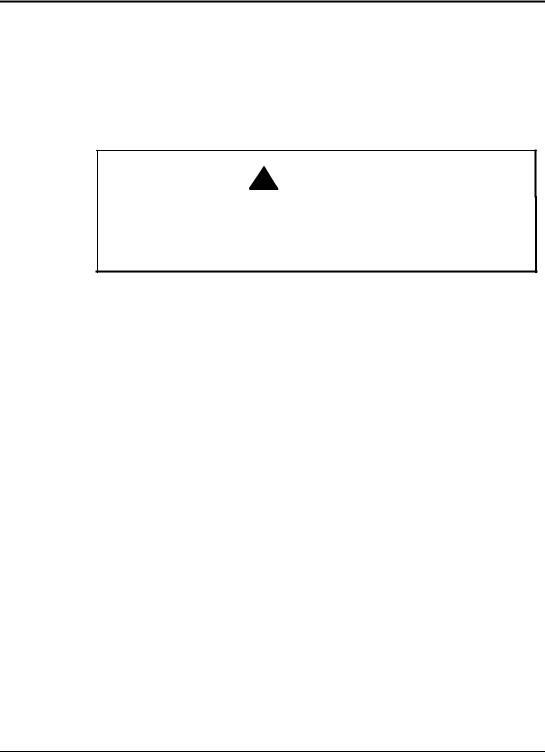
1 |
Getting Started |
! WARNING
Prolonged or improper use of a computer workstation may pose a risk of serious injury. To reduce your risk of injury, set up and use your computer in the manner described in Appendix A, “Setting Up a Healthy Work Environment.”
After completing the steps in the quick setup sheet that comes with your computer, your NEC Versa 4200 is ready to go! To get started, look at the following:
TRead Appendix A, “Setting Up a Healthy Work Environment,” for guidelines that help you use your computer productively and safely. Information includes how to set up and use your computer to reduce your risk of developing nerve, muscle, or tendon disorders.
TTake the on-line System Tour to get acquainted with the NEC Versa 4200.
TView the on-line Owner’s Manual in the NEC Versa 4200 InfoCenter.
TRead through this guide to familiarize yourself with the NEC Versa.
Getting Started 1-1
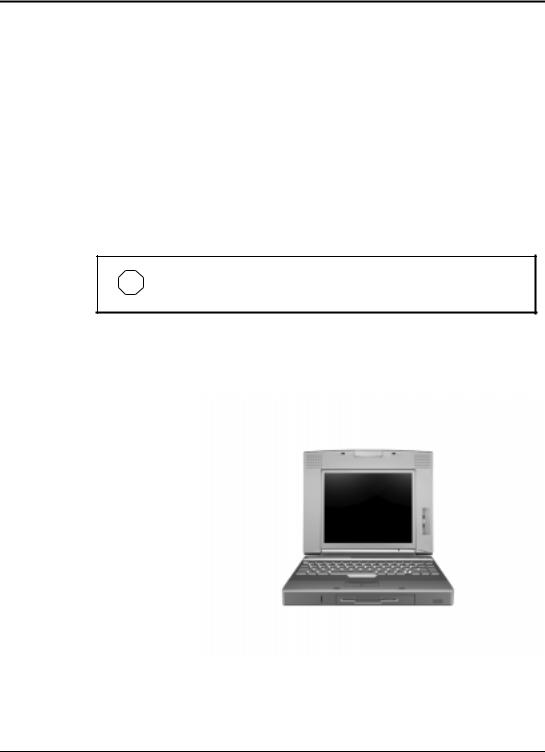
GETTING TO KNOW YOUR NEC VERSA 4200
The NEC Versa 4200 Series notebook computer offers you a portable system filled with exciting resources for home, business or travel. Standard features include a powerful Intel® Pentium 100 MHz or 133 MHz microprocessor that works together with the latest VL-Bus Accelerated Video architecture.
In addition, your system provides a high performance hard disk drive, floppy diskette drive (or interchangeable CD-ROM reader), and Personal Computer (PC) card support. As a multimedia system, your NEC Versa also provides the tools needed to create and present impressive images using video clips and sound.
NOTE
The CD-ROM Reader only ships with the 133MHz systems.
To get comfortable with your notebook, read the following sections and take a tour around your system!
NEC Versa 4200 Series notebook computer
1-2 Getting Started
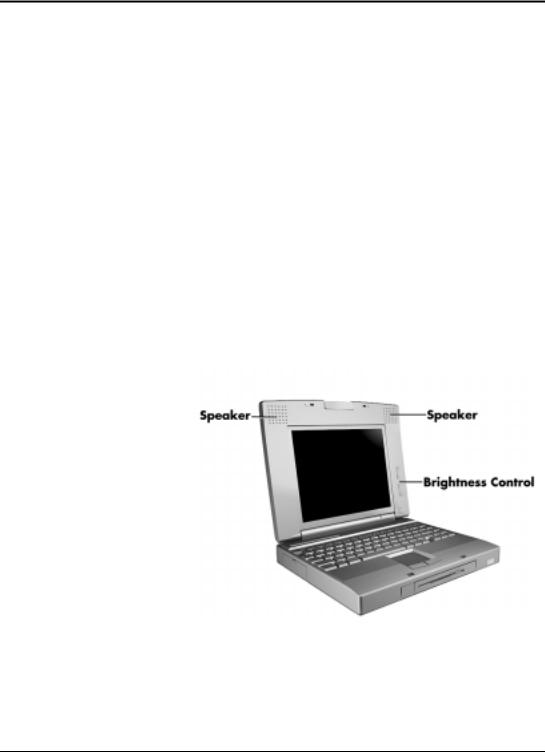
Around the System — Front
The NEC Versa 4200 is compact with features on every side. First, look at the front of the NEC Versa 4200. The following section describes the front features beginning with the liquid crystal display (LCD).
LCD
Your NEC Versa 4200 comes with a color liquid crystal display (LCD) that you can adjust for a comfortable viewing position. The LCD provides a 10.4-inch Super Video Graphics Array (SVGA) Thin Film Transistor (TFT) display.
LCD panel features include:
TBuilt-in Stereo Speakers — provides stereo sound for your multimedia presentations, or listening pleasure.
TBrightness Control — a slide switch to adjust the screen backlight brightness.
LCD features
Getting Started 1-3
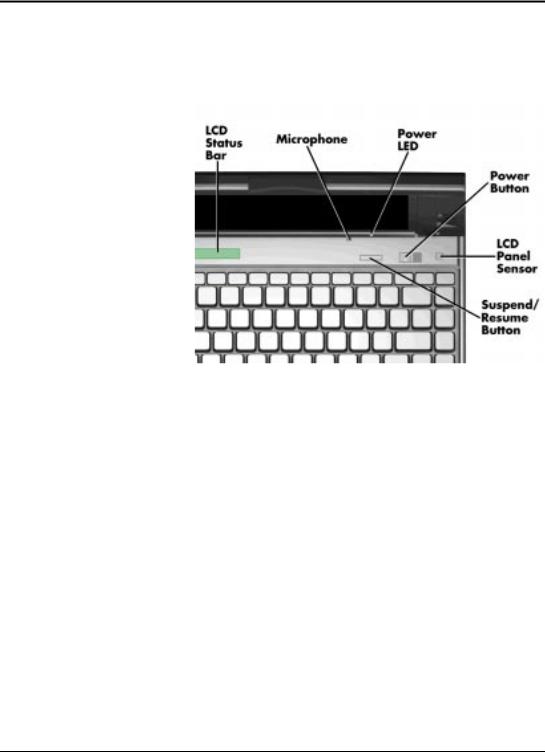
Controls and Microphone
The NEC Versa 4200 controls and the built-in microphone are shown in the following figure. These features are described after the figure.
Controls and microphone
TLCD Status Bar — the status panel keeps you informed about your NEC Versa’s current operating status. See “Status Icons” in the next section for icon descriptions.
TMicrophone — allows you to record monophonic sound directly into your notebook computer.
TPower LED
¾Lights green when the system is powered on.
¾Blinks green when the system is in Suspend mode.
¾Blinks amber to indicate that battery power is low and needs to be recharged.
TSuspend/Resume (S/R) Button — press the S/R button to put the unit into Suspend mode when you need to be away from your system for a short period of time and want to return to where you left off. Press S/R button again to bring the NEC Versa 4200 out of Suspend mode.
1-4 Getting Started
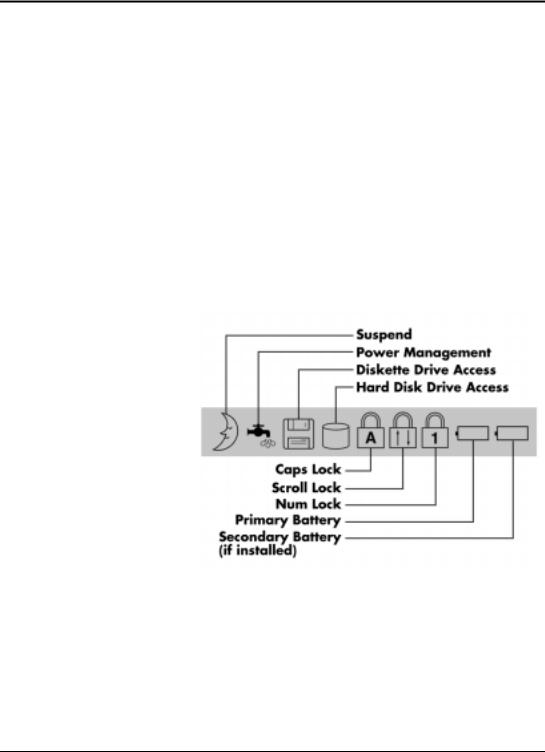
Specifically, suspend mode shuts down all devices in the system while retaining data and system status.
TPower Button — slide the power button to the right to power on and power off the notebook computer.
The power button is a “smart” switch, meaning that it recognizes when the system is in Suspend mode. You cannot power off the system until you press the suspend button and bring it out of Suspend mode first.
TLCD Panel Sensor— senses when the LCD panel is closed and turns off the panel.
Status Icons
The NEC Versa 4200 uses nine LCD icons that communicate system status. See the following figure and list for each icon’s meaning.
Reviewing status icons
TSuspend — appears when the system is in Suspend mode. Suspend mode conserves system power by shutting down all devices in the system while retaining data and system status.
Getting Started 1-5

TPower Management — shows the current power management mode in use, including Off, Longest battery life, Highest performance, or Custom settings.
TDiskette Drive Access — appears when writing data to or retrieving from a diskette.
THard Disk Drive Access — shows when writing data to or retrieving data from the system’s hard disk.
TCaps Lock — appears when caps lock is in effect.
TScroll Lock — shows that scroll lock is in effect.
TNum Lock — appears when Num Lock mode is active.
TBattery — displays the percent of battery power available. If you have two battery packs installed, two battery icons appear.
¾4 bars indicate a 76 - 100% charge
¾3 bars indicate a 51 - 75% charge
¾2 bars indicate a 26 - 50% charge
¾1 bar indicates a 1 - 25% charge.
NOTE
When installing a new battery, the first and third bars on the battery gauge may flash. This indicates an unknown battery status. To correct the reading, recharge your battery for a minimum of 8 hours. If the battery still shows an unknown status, contact the dealer from whom you purchased the battery for a replacement.
1-6 Getting Started
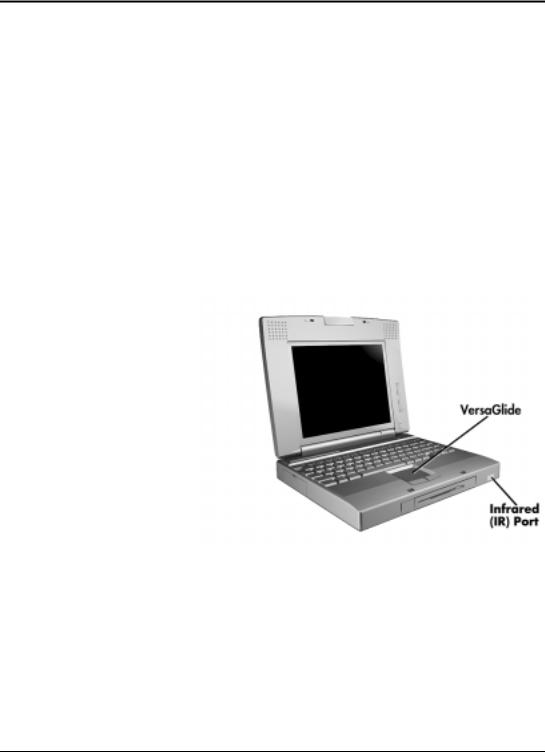
Keyboard
The NEC Versa 4200 keyboard uses 83 keys (79 keys for International), with the standard QWERTY-key layout. See Chapter 4, “Keyboard” for details. You can also refer to the on-line information in the NEC Versa 4200 InfoCenter.
Infrared (IR) Port
The infrared (IR) port on your system lets your NEC Versa 4200 communicate with other devices with infrared ports. You can easily transfer files between your NEC Versa and another IR-equipped computer or print to an IR-equipped printer without using cables. (Device drivers are required for some devices including printers.)
This port is Serial-Infrared (S-IR), IrDA compatible.
NEC VersaGlide
The NEC VersaGlide works like a standard computer mouse. Simply move your fingertip over the VersaGlide to control the position of the cursor. Use the selection buttons below the VersaGlide to select and deselect menu items. Or, single tap on the VersaGlide to select and double tap to execute.
Getting Started 1-7

Diskette Drive, CD-ROM Reader, and the NEC VersaBay II™
Depending on the NEC Versa 4200 model you purchased, either a 1.44-MB diskette drive or a 6x CD-ROM drive is installed in the VersaBay II. If your system has the 1.44-MB diskette drive, you can remove it from the VersaBay II and replace it with the 6x CD-ROM reader. It’s your choice!
The VersaBay II lets you install additional options, including an optional second Li-Ion battery or an additional hard disk drive, see “Customizing Your System with the VersaBay II,” in Chapter 4 for more details.
VersaBay II
1-8 Getting Started
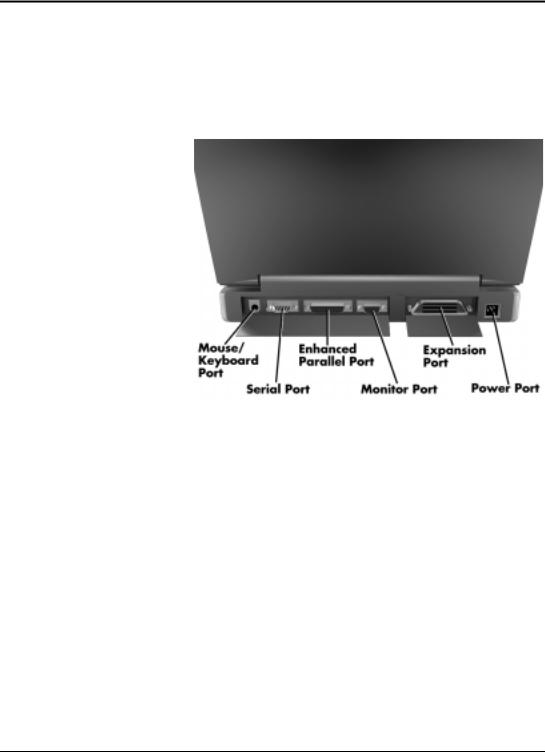
AROUND THE SYSTEM — BACK
You’ll find system ports for connecting your NEC Versa 4200 to optional devices (like a printer, docking station, or external monitor) on the back of your NEC Versa. For an understanding of each feature, see the descriptions that follow the figure.
Back system features
TMouse/Keyboard Port — Use the standard PS/2 port to connect an external PS/2-style mouse or a PS/2-style keyboard to the system. With an optional Y-cable adapter, you can connect both a mouse and a keyboard at the same time. Note that the VersaGlide is disabled when an external mouse is connected.
TSerial Port — Use this port to connect an external modem or other serial device. A serial cable has a 9-pin connector.
TEnhanced Parallel Port (EPP) — Use this port to connect a parallel printer or other parallel device. A parallel cable has a 25-pin cable connector. The Versa 4200 series also supports Extended Capability Port (ECP).
TMonitor (Video) Port — Use this 15-pin connector port to attach an external monitor to your NEC Versa. You can run the LCD display and the external monitor simultaneously or run each alone.
Getting Started 1-9

TExpansion Port — This bus connector is dedicated to the optional NEC PortBar 4000 or NEC Versa Docking Station 4000.
TPower Port — Use the power jack to attach the NEC Versa to an AC or DC power source such as the AC adapter or the available car adapter.
AROUND THE SYSTEM — LEFT SIDE
The left side of your NEC Versa 4200 has two slots for inserting two Type II PC Cards (formerly called PCMCIA cards). You can also insert one Type III PC Card. The PC Card is a standard interface for peripheral devices. It is about the size and shape of a credit card and is inserted into one of the PC Card slots.
The battery bay cover release is also located on the left side of the unit. The battery bay (located on the bottom of the unit) contains a Lithium Ion (LiIon) battery that lets you run your system on DC power.
Left side features
1-10 Getting Started
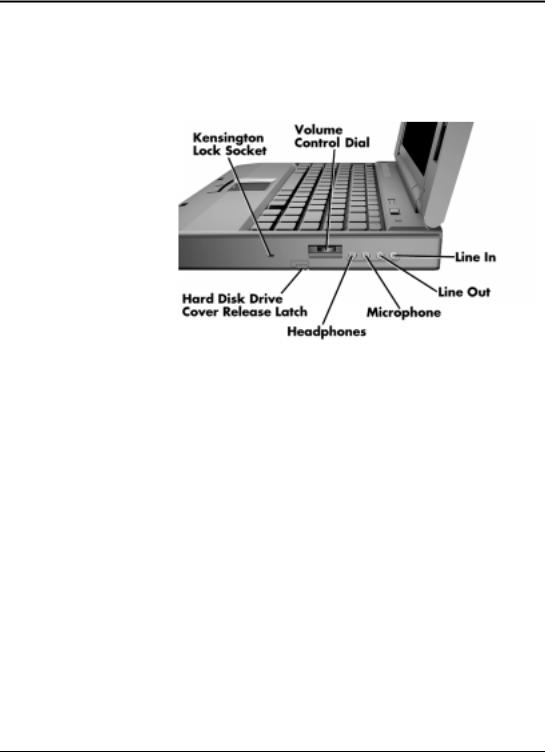
AROUND THE SYSTEM — RIGHT SIDE
The Kensington lock socket, hard disk drive, cover release latch, and audio ports are located on the right-side of the NEC Versa 4200. For an understanding of each feature, see the descriptions that follow the figure.
Right side features
TKensington Lock Socket — Lets you provide added security by installing an optional Kensington Lock.
THard Disk Drive Cover Release Latch — Used to release and remove the cover to gain access to the hard disk drive bay, which contains the removable hard disk drive.
TVolume Control Dial — Allows you to control the speaker and headphone volume.
THeadphones — Lets you connect external headphones or speakers to
your NEC Versa 4200. Plugging in headphones disables the built-in system speakers.
TMicrophone (MIC) — Allows you to connect an external microphone for monophonic recording or amplification through the unit. Plugging in an external microphone disables the built-in microphone.
Getting Started 1-11
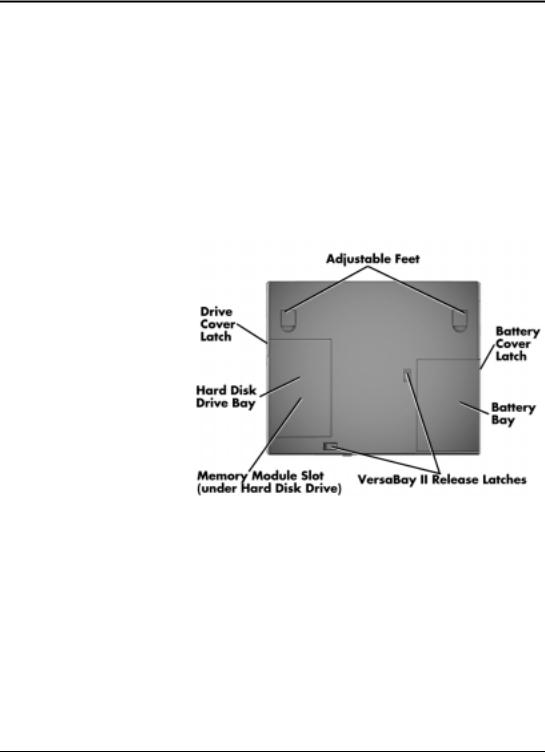
TLine-Out — Lets the NEC Versa 4200 act as an input source for another audio system. Connect this port to a Line-In port on another audio system to play or record.
TLine-In — Lets you use another audio system, like a home stereo, as an input source. Use a cable to connect to the Line-Out port on the other audio system to record or play.
AROUND THE SYSTEM — BOTTOM
The bottom of the NEC Versa 4200 contains the features shown. For an understanding of each feature, see the descriptions that follow the figure.
Bottom features
THard Disk Drive Bay — Contains the system’s standard hard disk drive. If you remove the hard disk drive, you’ll see a memory module connector for expanding system memory. You’ll also see four dip switches. These are explained in Chapter 4, “Using Your Hardware.”
When you turn the system upside down with the front towards you, the hard disk drive is located on the left front of the system.
TMemory Module Slot — Located just under the hard disk drive, this slot lets you add an optional memory card to expand your system’s memory. See the online Options Catalog for a list of available memory options.
1-12 Getting Started

TNEC VersaBay II Release Latches — These latches release the device, such as diskette drive, CD-ROM reader, etc. currently installed in the bay.
TAdjustable Feet — The adjustable feet let you change the angle and level of the NEC Versa 4200.
TBattery Bay — Contains the system’s standard Lithium Ion (Li-Ion) battery that lets you run your system on DC power. The battery bay is located on the right front of the system when the system is upside down with the front towards you.
POWER SOURCES FOR YOUR NEC VERSA
The NEC Versa 4200 can be powered using three different sources, making it a truly portable system. Operate your NEC Versa 4200 just about anywhere using one of the following power sources:
Tthe AC adapter connected to an electrical wall outlet (using AC power)
Tthe battery pack and/or an optional second battery pack
Tthe optional DC adapter connected to a car cigarette lighter.
Read the following sections for specific steps on powering on the system.
Using the AC Adapter
Use the AC adapter that came with your NEC Versa to run your computer on alternating current (AC) power, or to recharge the battery pack. Use the AC adapter whenever a wall outlet is nearby.
Keep the adapter connected whenever possible. The AC adapter charges the battery whether or not you are using the NEC Versa.
Getting Started 1-13
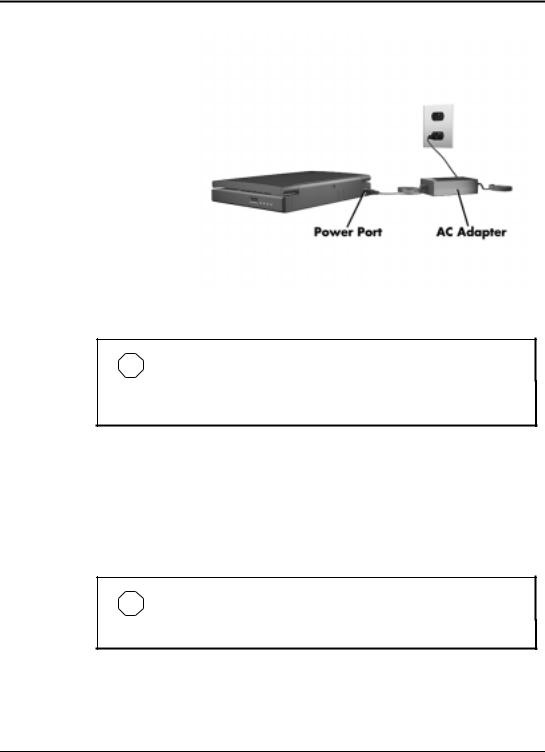
AC Power Adapter
NOTE
Check that the AC outlet voltage falls in the range of 100–240 Volts AC. Verify that the cord and plug are appropriate for your AC source.
Connect the AC adapter as follows:
1.With the front of the NEC Versa facing you, connect the AC adapter cable to the power port on the back left side of your NEC Versa 4200.
2.Plug one end of the AC power cable into the AC adapter and the other end into a properly grounded 120or 240-volt wall outlet.
NOTE
Different countries use different types of AC power cables. Contact a local dealer to purchase the correct power cable.
1-14 Getting Started

Powering on
Power on the system as follows.
1.Locate the latch on the front of the LCD panel, press the latch up, and raise the panel.
2.Locate the power button (see the following figure) and slide it to the right to turn on system power.
Powering on the system
Using the Main Battery Pack
The NEC Versa 4200 comes with a rechargeable Lithium Ion (Li-Ion) battery pack. You can run your system on battery power for up to 5.5 hours with Power Management or 2.5 hours without Power Management. The battery is easy to install and remove.
Your NEC Versa 4200 provides some tools to help you monitor the battery power level; the status bar icons described earlier in this chapter, and the battery gauge in the Power Panel toolbar. Both let you know how much battery power remains. See Chapter 3, Using Setup, for more details on using PowerPanel.
Getting Started 1-15

NOTE
When installing a new battery, the first and third bars on the battery gauge may flash. This indicates an unknown battery status. To correct the reading, recharge your battery for a minimum of 8 hours. If the battery still shows an unknown status, contact the dealer from whom you purchased the battery for a replacement.
When battery power is very low, a single bar on the battery status LCD blinks. If the system speaker is enabled, 3 low battery warning beeps are emitted.
When battery power gets low, do any of the following:
TPut your system in Suspend mode, remove the battery pack, and replace it with a fully charged Li-Ion battery.
TLeave the battery pack in the system and connect your NEC Versa to the AC adapter and a wall outlet. If you connect the system to AC power, the battery recharges in 2.5 hours, or more depending on the system usage.
TLeave the battery pack in the system and connect your NEC Versa to the optional NEC Versa 4000 DC car adapter (system runs on car battery power.)
You can also buy an optional battery charger to quickly charge your battery. See the on-line Options Catalog.
! WARNING
To prevent accidental battery ignition or explosion, adhere to the following:
TKeep the battery away from extreme heat.
TKeep metal objects away from the battery terminals to prevent causing a short circuit.
TMake sure the battery is properly installed in the battery bay.
TRead the precautions printed on the battery itself and in the online Owner’s Manual in the NEC Versa 4200 InfoCenter.
1-16 Getting Started
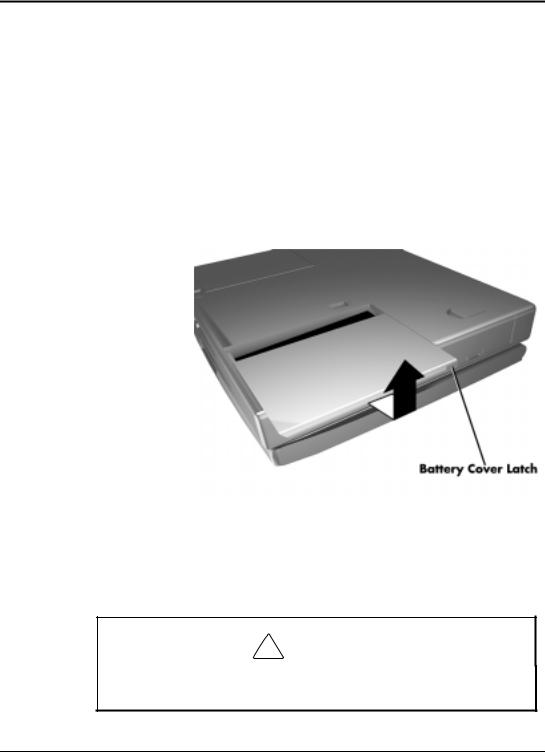
Replacing the Battery Pack
Replace the battery pack installed in your NEC Versa system as follows.
1.Save your files, exit Windows, and press the Suspend button or turn off the system power.
2.Close the LCD and turn the system over.
3.Release the battery cover latch and slide the battery bay cover away from the system.
4.Then lift the cover up and away from the system.
Removing the cover
5.Locate the notched corner on the battery. Placing your fingers in the notched corner, lift the battery out of the system.
! CAUTION
Always lift the battery out of the system by the notched end. Failure to do so can damage the battery terminals.
Getting Started 1-17

Removing the battery
6.Insert the new battery as follows:
T Align the battery terminals with the terminals in the system.
T Lower the terminal end of the battery pack into the bay.
T Next, lower the notched end into the bay.
! CAUTION
When installing a battery pack, be careful not to twist the terminals.
1-18 Getting Started
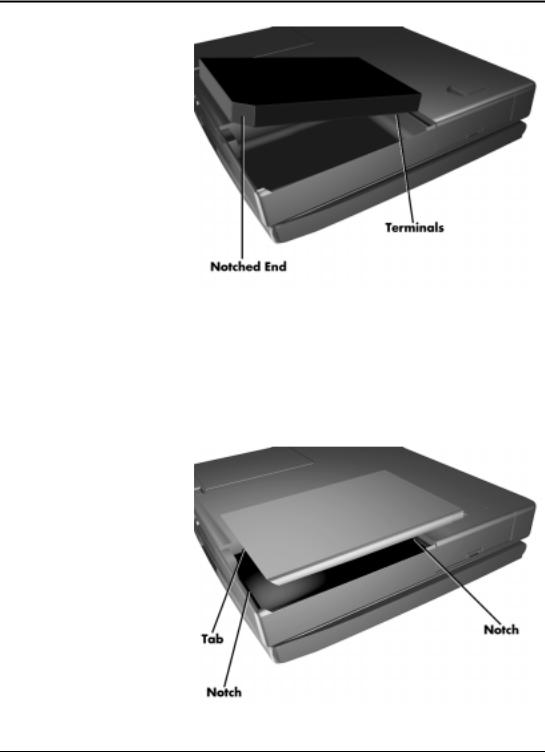
Inserting the battery pack
7.Replace the battery bay cover as follows:
T Align the tabs on the battery cover with the notches in the system.
T Lower the cover onto the system.
TSlide the cover towards the middle of the unit until the cover locks into place.
Replacing the cover
Getting Started 1-19
